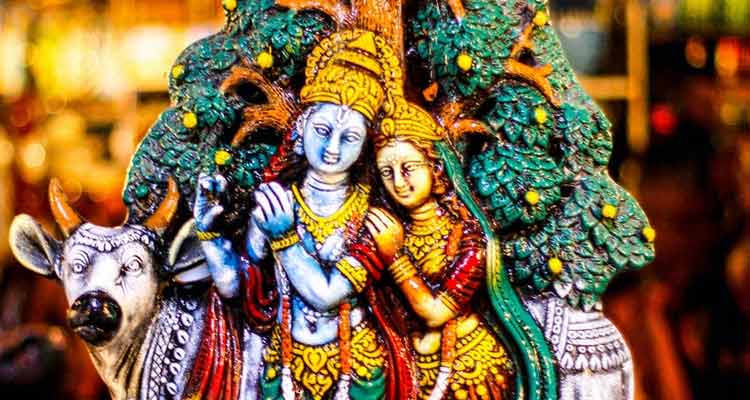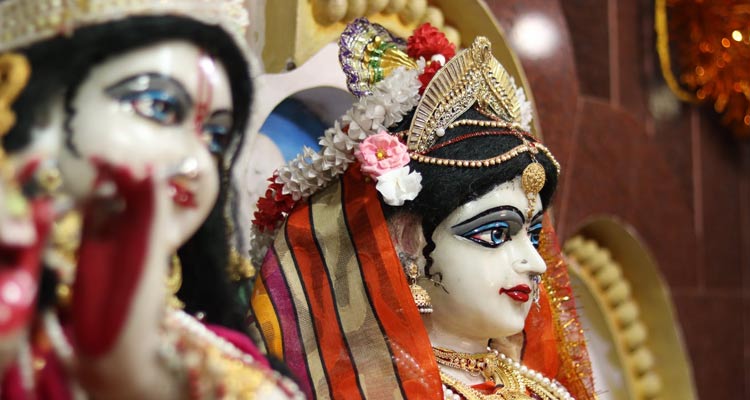Radha-Krishna Love Story
The funny thing is that Radha, who we take so much for granted, didn’t always exist. Her character is a late entrant in Indian mythology as compared to her eternal paramour, Krishna. Not many know that Radha is nowhere to be found in the Mahabharata, where we meet Krishna fairly extensively. In the Bhagavata Purana too, which was composed a few centuries after the epic, we only find the mention of a ‘special gopi’.Radha is not named in this text, which is one of the most exhaustive eulogies to Krishna. Barring some passing references, Radha does not blossom in our imaginations entirely until Jayadev’s 12th century CE magnum opus, ‘Gita Govind’. This path-breaking Sanskrit kavya text became pivotal in fixing Radha’s place in popular culture and there has been no looking back. Since then the romance of Radha and Krishna’s love became ingrained in our consciousness. A love that transcended time, space, and social mores. As Vaishnava literature around the Radha lore grew, we came to know her as the most beautiful gopi of Vrindavan. Born in Barsana to Vrishbhanu and Kirtida, Radha charmed her way into Krishna’s life, and became a major fixture in the narrative of Krishna’s childhood and youth. Accompanied by her two closest sakhis, Lalita and Vishakha, Radha was witness to and part of many of Krishna’s Vrindavan adventures. She became the paradigm of shringara bhakti (roughly, romantic devotion) to the extent that we cannot imagine Krishna without Radha today. But what makes the Radha- Krishna love story the greatest of all?
Love lessons modern couples can learn from Radha and Krishna
What makes Krishna and Radha’s romance the epitome of all romances is the fact that it features all the DO NOTs. Two most popular tropes about Radha that make this affair so interesting are: – Radha was an older woman – Radha was a married woman But for Krishna’s divinity, which explains all transgressions as leela, everything about this relationship is wrong…at least by regular standards. A patriarchal, monogamous (and often hypocritical) society has drilled it into our heads that it is not okay for a man to have romantic liaisons with older women and it is definitely not okay to do so if she is married to another. But the Vaishnava authors of yore made no bones about the ‘illegitimacy’ of this divine dalliance. This bold relationship was designed to challenge every social norm and yet Krishna emerged on the other side as the ‘purnavataar’ – the god who was a perfect man. What of Radha? She had to bear the weight of many labels – kalankini being one of them. But that was a small price to pay for having a place by Krishna’s side forever after. These acts were inspired by a love so pure and true that social contexts and laws become minor details. Radha and Krishna were perfect in their devotion and attraction to each other, and one complemented and completed the other. This sensual, emotional and intellectual chemistry is demonstrated in story after story and this is what makes their love extraordinary. However, it is the essential separation of the two lovers and the ensuing heartbreak at the end that makes the story paradigmatic.
Two bodies, one spirit
Of the many themes and tales about Radha and Krishna, one stands out most poignantly in this author’s mind. Here, the couple cross dress – Radha as Krishna and Krishna as Radha – to please each other. This seemingly quaint equation is vaguely reflected in old texts like the Vishnu and Padma Puranas, and more clearly in a modern Thumri composition called ‘Tum Radhe Bano Shyam’. “Dressing up as a gopi is the Dark Lord’s pastime called dan leela or matuki leela,” explains Srila Rupa Goswami in his famous Vaishnava work, ‘The Nectar of Devotion’. A small cult in Eastern India – the Sakhi Bekhis – still practices such as emulative cross-dressing as an act of bhakti. Here, male Krishna bhakts dress up like women to fully experience the ‘Radha bhaav’ of devotion – much like Lord Chaitanya in the 16th century CE Bengal. What is the relationship between Radha and Krishna? It is the kind of love that transcends every inhibition, all shame. It is embracing one’s lover in every sense of the word – their gender, their identity, their very soul. Nothing is held back, there are no holds barred. Witnessed in the context of loving devotion, this act of cross-dressing seems odd no more. Women in the 21st century also routinely hijack their boyfriends’ jeans and flaunt them with pride, don’t they?



